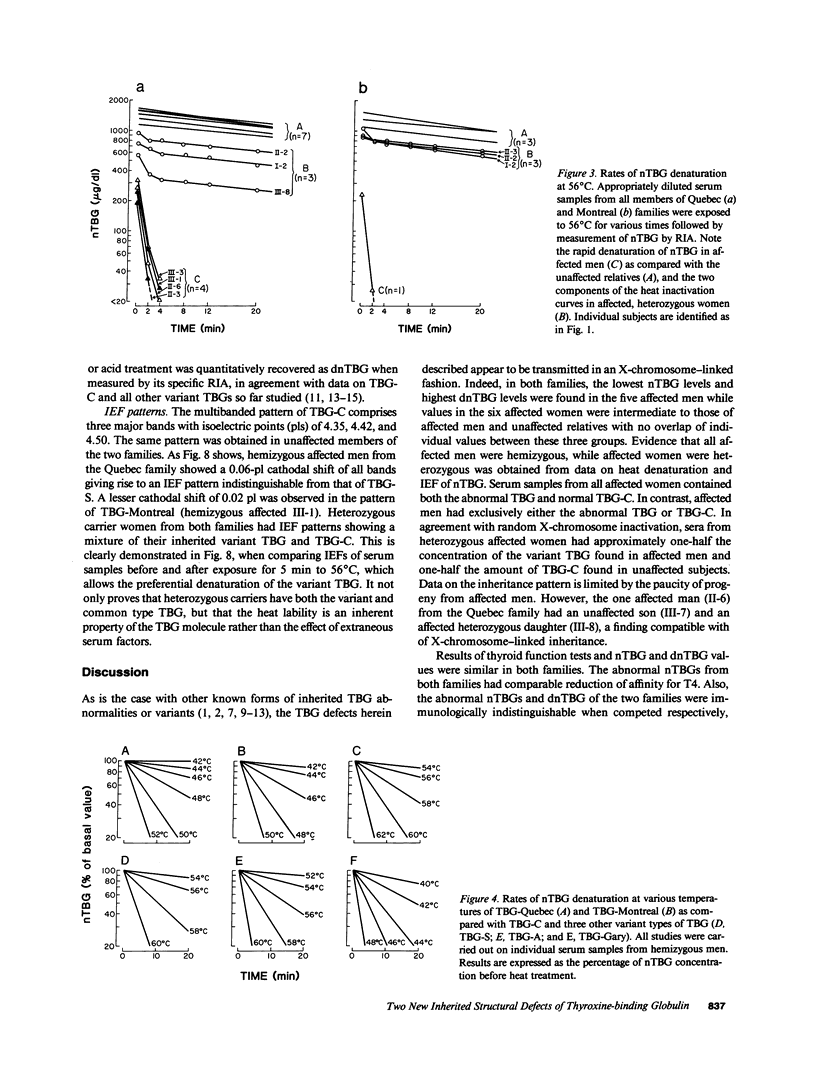Abstract
Serum-denatured TBG (dnTBG) measured in 32 families deficient in native TBG (nTBG) was undetectable in all subjects with complete nTBG deficiency and was high in 2 of 16 families with partial nTBG deficiency. nTBG (in mean micrograms per decaliter +/- SD) in members of the Quebec and Montreal families, respectively were: 258 +/- 54 and 230 in affected men, 747 +/- 190 and 927 +/- 90 in affected women, and 1568 +/- 151 and 1300 +/- 195 in unaffected relatives. Corresponding mean dnTBG levels were: 14.3 +/- 2.9 and 21.3 in affected men, 8.6 +/- 1.0 and 11.6 +/- 3.1 in affected women, and less than 2.1 and less than 2.6 in unaffected relatives. All were euthyroid with normal free thyroxine and thyrotropin levels. In comparison to common type TBG, TBG-Quebec was more heat labile by 10 degrees C and TBG-Montreal by 12 degrees C. The degree of dnTBG elevation and nTBG lability at 37 degrees C were correlated (r = 0.99). Isoelectric focusing showed cathodal shift of all TBG bands: TBG-Quebec by 0.06 isoelectric points (pI) and TBG-Montreal by 0.02 pI. These two TBG variants represent different mutations most likely affecting the polypeptide chain of the molecule. Their inheritance is X-chromosome linked. The instability of these TBGs at 37 degrees C may lead to more rapid degradation in vivo resulting in low nTBG and high dnTBG concentrations in serum.
Full text
PDF







Images in this article
Selected References
These references are in PubMed. This may not be the complete list of references from this article.
- Amino N., Hagen S. R., Yamada N., Refetoff S. Measurement of circulating thyroid microsomal antibodies by the tanned red cell haemagglutination technique: its usefulness in the diagnosis of autoimmune thyroid diseases. Clin Endocrinol (Oxf) 1976 Mar;5(2):115–125. doi: 10.1111/j.1365-2265.1976.tb02822.x. [DOI] [PubMed] [Google Scholar]
- BEIERWALTES W. H., ROBBINS J. Familial increase in the thyroxine-binding sites in serum alpha globulin. J Clin Invest. 1959 Oct;38:1683–1688. doi: 10.1172/JCI103946. [DOI] [PMC free article] [PubMed] [Google Scholar]
- Burr W. A., Ramsden D. B., Hoffenberg R. Hereditary abnormalities of thyroxine-binding globulin concentration. A study of 19 kindreds with inherited increase or decrease of thyroxine-binding globulin. Q J Med. 1980;49(195):295–313. [PubMed] [Google Scholar]
- Daiger S. P., Rummel D. P., Wang L., Cavalli-Sforza L. L. Detection of genetic variation with radioactive ligands. IV. X-linked, polymorphic genetic variation of thyroxin-binding globulin (TBG). Am J Hum Genet. 1981 Jul;33(4):640–648. [PMC free article] [PubMed] [Google Scholar]
- Daiger S. P., Wildin R. S. Human thyroxine-binding globulin (TBG): heterogeneity within individuals and among individuals demonstrated by isoelectric focusing. Biochem Genet. 1981 Aug;19(7-8):673–685. doi: 10.1007/BF00484000. [DOI] [PubMed] [Google Scholar]
- Dick M., Watson F. A possible variant of thyroxine-binding globulin in Australian Aborigines. Clin Chim Acta. 1981 Nov 11;116(3):361–367. doi: 10.1016/0009-8981(81)90055-3. [DOI] [PubMed] [Google Scholar]
- Grimaldi S., Bartalena L., Ramacciotti C., Robbins J. Polymorphism of human thyroxine-binding globulin. J Clin Endocrinol Metab. 1983 Dec;57(6):1186–1192. doi: 10.1210/jcem-57-6-1186. [DOI] [PubMed] [Google Scholar]
- Gärtner R., Henze R., Horn K., Pickardt C. R., Scriba P. C. Thyroxine-binding globulin: investigation of microheterogeneity. J Clin Endocrinol Metab. 1981 Apr;52(4):657–664. doi: 10.1210/jcem-52-4-657. [DOI] [PubMed] [Google Scholar]
- Horwitz D. L., Refetoff S. Graves' disease associated with familial deficiency of thyroxine-binding globulin. J Clin Endocrinol Metab. 1977 Feb;44(2):242–247. doi: 10.1210/jcem-44-2-242. [DOI] [PubMed] [Google Scholar]
- Murata Y., Magner J. A., Refetoff S. The role of glycosylation in the molecular conformation and secretion of thyroxine-binding globulin. Endocrinology. 1986 Apr;118(4):1614–1621. doi: 10.1210/endo-118-4-1614. [DOI] [PubMed] [Google Scholar]
- Murata Y., Refetoff S., Sarne D. H., Dick M., Watson F. Variant thyroxine-binding globulin in serum of Australian aborigines: its physical, chemical and biological properties. J Endocrinol Invest. 1985 Jun;8(3):225–232. doi: 10.1007/BF03348482. [DOI] [PubMed] [Google Scholar]
- Murata Y., Takamatsu J., Refetoff S. Inherited abnormality of thyroxine-binding globulin with no demonstrable thyroxine-binding activity and high serum levels of denatured thyroxine-binding globulin. N Engl J Med. 1986 Mar 13;314(11):694–699. doi: 10.1056/NEJM198603133141107. [DOI] [PubMed] [Google Scholar]
- Refetoff S., Fang V. S., Marshall J. S., Robin N. I. Metabolism of thyroxine-binding globulin in man. Abnormal rate of synthesis in inherited thyroxine-binding globulin deficiency and excess. J Clin Invest. 1976 Feb;57(2):485–495. doi: 10.1172/JCI108301. [DOI] [PMC free article] [PubMed] [Google Scholar]
- Refetoff S., Hagen S. R., Selenkow H. A. Estimation of the T 4 binding capacity of serum TBG and TBPA by a single T 4 load ion exchange resin method. J Nucl Med. 1972 Jan;13(1):2–12. [PubMed] [Google Scholar]
- Refetoff S., Murata Y., Vassart G., Chandramouli V., Marshall J. S. Radioimmunoassays specific for the tertiary and primary structures of thyroxine-binding globulin (TBG): measurement of denatured TBG in serum. J Clin Endocrinol Metab. 1984 Aug;59(2):269–277. doi: 10.1210/jcem-59-2-269. [DOI] [PubMed] [Google Scholar]
- Refetoff S., Murata Y. X-chromosome-linked inheritance of the variant thyroxine-binding globulin in Australian aborigines. J Clin Endocrinol Metab. 1985 Feb;60(2):356–360. doi: 10.1210/jcem-60-2-356. [DOI] [PubMed] [Google Scholar]
- Refetoff S., Robin N. I., Alper C. A. Study of four new kindreds with inherited thyroxine-binding globulin abnormalities. Possible mutations of a single gene locus. J Clin Invest. 1972 Apr;51(4):848–867. doi: 10.1172/JCI106880. [DOI] [PMC free article] [PubMed] [Google Scholar]
- Refetoff S., Selenkow H. A. Familial thyroxine-binding globulin deficiency in a patient with Turner's syndrome (XO). Genetic study of a kindred. N Engl J Med. 1968 May 16;278(20):1081–1087. doi: 10.1056/NEJM196805162782002. [DOI] [PubMed] [Google Scholar]
- Robbins J., Cheng S. Y., Gershengorn M. C., Glinoer D., Cahnmann H. J., Edelnoch H. Thyroxine transport proteins of plasma. Molecular properties and biosynthesis. Recent Prog Horm Res. 1978;34:477–519. doi: 10.1016/b978-0-12-571134-0.50017-x. [DOI] [PubMed] [Google Scholar]
- Robin N. I., Hagen S. R., Collaço F., Refetoff S., Selenkow H. A. Serum tests for measurement of thyroid function. Hormones. 1971;2(5):266–279. doi: 10.1159/000178240. [DOI] [PubMed] [Google Scholar]
- Takamatsu J., Ando M., Weinberg M., Refetoff S. Isoelectric focusing variant thyroxine-binding globulin in American blacks: increased heat lability and reduced serum concentration. J Clin Endocrinol Metab. 1986 Jul;63(1):80–87. doi: 10.1210/jcem-63-1-80. [DOI] [PubMed] [Google Scholar]




